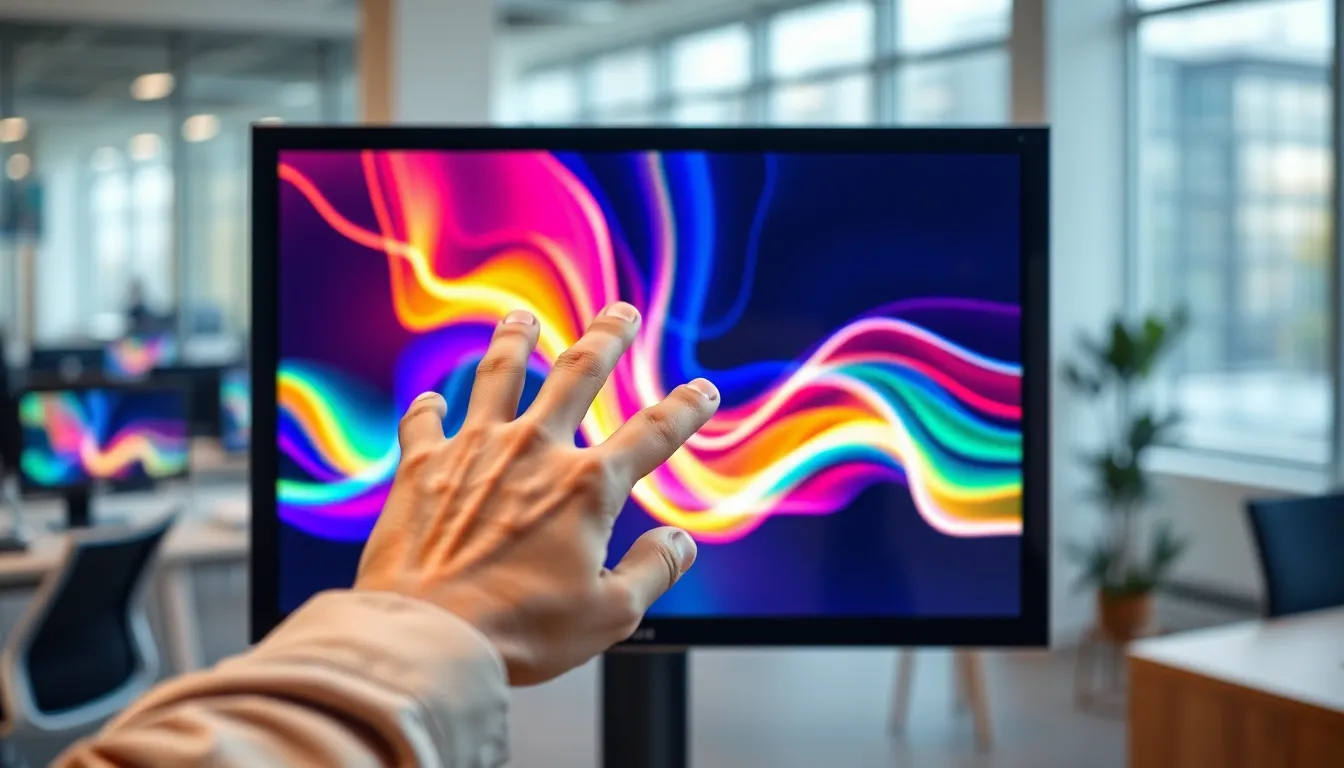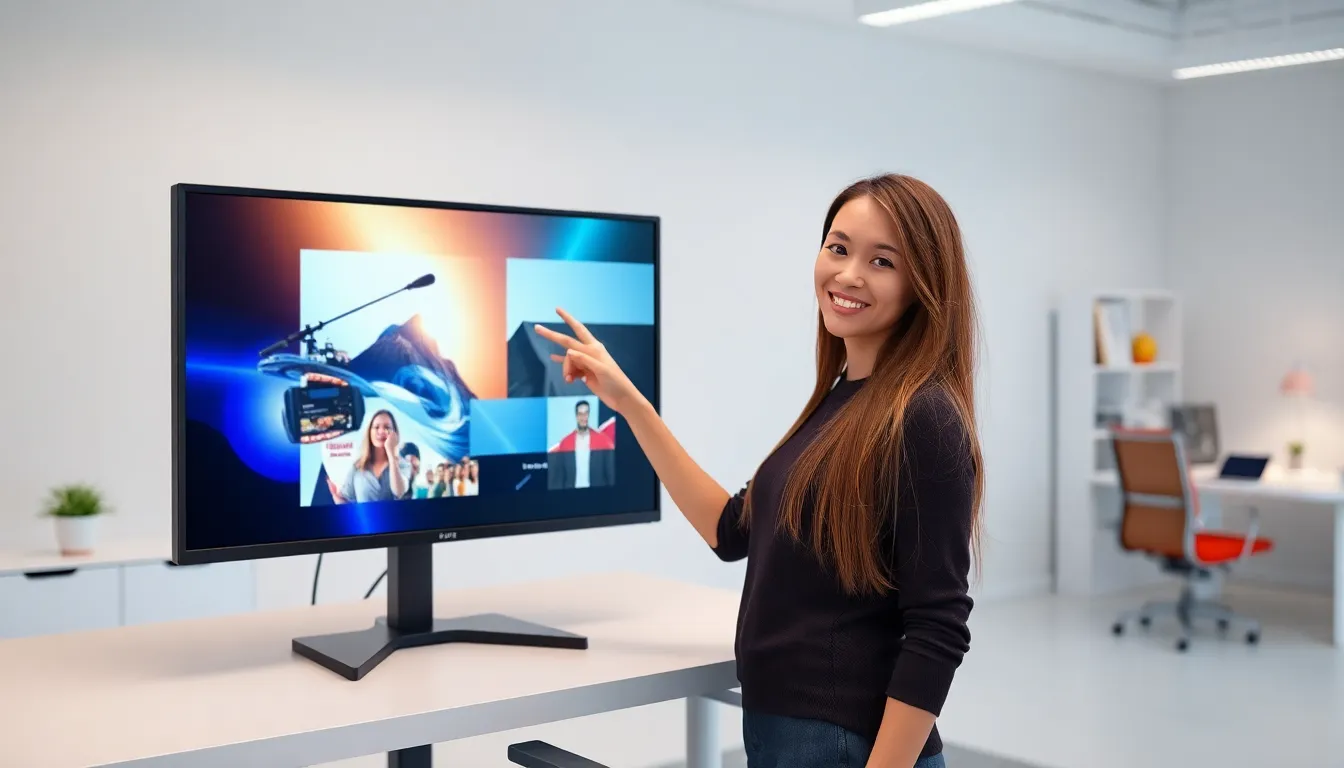Table of Contents
ToggleTouchscreen monitors have transformed the way people interact with technology, making tasks more intuitive and engaging. With a simple tap or swipe, users can navigate complex systems and access information at their fingertips. This evolution in display technology has not only enhanced personal devices but has also revolutionized industries like education, healthcare, and retail.
As touchscreen monitors continue to gain popularity, understanding their features and benefits becomes essential for anyone looking to upgrade their workspace or improve their user experience. From multi-touch capabilities to high-definition displays, these monitors offer a range of options that cater to diverse needs. Embracing this technology can lead to increased productivity and a more interactive environment, making it a worthwhile investment for both individuals and businesses alike.
Overview Of Touchscreen Monitors
Touchscreen monitors serve as vital tools in modern technology interaction. They combine display and input functionality, allowing users to operate devices directly through touch gestures. Available in various sizes and resolutions, touchscreen monitors cater to multiple applications, such as kiosk displays, interactive whiteboards, and personal computing.
Touchscreen technology includes resistive, capacitive, and infrared types.
- Resistive touchscreens utilize pressure from fingers or styluses to register inputs. These displays are cost-effective and effective for environments requiring durability, like industrial settings.
- Capacitive touchscreens respond to the electrical properties of the human body. These monitors support multi-touch gestures, enhancing user experience in mobile devices and consumer electronics.
- Infrared touchscreens use an array of sensors to detect touch by measuring interruptions in the light field, suitable for larger displays like information kiosks.
The multi-touch capabilities enable more interactive experiences, allowing users to zoom, rotate, and manipulate content intuitively. High-definition displays enhance visual quality, proving essential for applications involving graphics, design, and education.
Touchscreen monitors contribute significantly to sectors like healthcare, where they facilitate patient data management, and retail, where they enhance customer engagement through interactive product displays. In educational environments, they promote collaborative learning and encourage active participation.
As technology advances, touchscreen monitors continue to evolve, integrating improved touch sensitivity, better screen durability, and advanced software compatibility, thereby elevating their functionality and increasing their adoption across various fields.
Types Of Touchscreen Monitors

Touchscreen monitors vary in technology and application, catering to diverse user needs and environments. The key types include capacitive and resistive touchscreen monitors, each offering distinct advantages for specific uses.
Capacitive Touchscreen Monitors
Capacitive touchscreen monitors use an electrostatic field to detect touch, providing high sensitivity and multi-touch capabilities. These monitors are responsive to finger taps and gestures, making them suitable for applications requiring intricate interactions, like smartphones and tablets. With superior clarity and brightness, capacitive screens often feature high-definition displays that enhance visual experiences. They generally exhibit greater durability and longevity due to their glass surfaces, which are resistant to scratches. Industries like retail and education favor capacitive touchscreens for their intuitive interfaces and engaging user experiences.
Resistive Touchscreen Monitors
Resistive touchscreen monitors operate through pressure applied to the screen’s surface. These screens consist of two flexible layers separated by a small gap. When pressure is applied, the layers touch, registering the coordinates of the touch. Resistive monitors excel in environments ranging from industrial settings to applications requiring stylus input. They are durable against dust and liquids, making them ideal for harsher conditions. Although resistive touchscreens may support only single-touch functionality, they typically offer lower costs and ease of integration into existing systems, suitable for various basic uses in healthcare and point-of-sale environments.
Advantages Of Touchscreen Monitors
Touchscreen monitors offer several advantages, enhancing user interaction and functionality across various settings. By integrating advanced technology, these monitors improve overall efficiency and convenience.
Enhanced User Experience
Enhanced user experience defines touchscreen monitors. They allow for direct manipulation of on-screen content, creating an intuitive and engaging interface. Multi-touch support enables users to perform complex gestures, like pinch-to-zoom and swiping, facilitating easier navigation. Touchscreens reduce the learning curve associated with traditional input devices, making technology more accessible to all users. Interactive features cater to diverse applications, such as educational tools that foster active participation and retail displays that promote customer engagement. Enhanced graphical clarity in high-definition displays complements this seamless interaction.
Space-Saving Design
Space-saving design serves as a significant advantage of touchscreen monitors. Their all-in-one functionality combines display and input in a singular device, reducing the need for additional peripherals like keyboards and mice. This compact nature is especially beneficial in environments with limited workspace, such as small offices and retail counters. Wall-mounted options further maximize floor space, allowing organizations to create more flexible and efficient layouts. By streamlining equipment, touchscreen monitors contribute to a cleaner, more organized work environment, enhancing overall aesthetics and user comfort.
Considerations When Buying Touchscreen Monitors
Selecting the right touchscreen monitor requires careful evaluation of specific features. Two critical aspects are size and resolution, along with connectivity options.
Size And Resolution
Size and resolution significantly affect the usability and effectiveness of touchscreen monitors. Common sizes range from 15 to 32 inches, accommodating various applications, from small workspaces to larger kiosks. Higher resolution monitors, such as Full HD (1920 x 1080) or 4K (3840 x 2160), offer clearer visuals, enhancing detail and color accuracy for professional tasks or media consumption. A larger screen with higher resolution provides immersive experiences, particularly for applications in healthcare and design, where precision matters.
Connectivity Options
Connectivity options determine how a touchscreen monitor integrates with other devices. Common interfaces include HDMI, DisplayPort, and USB, facilitating easy connections to laptops, desktops, and media players. Monitors with multiple ports provide flexibility, allowing simultaneous connections. Additionally, Wi-Fi or Bluetooth capabilities enable wireless interactions, eliminating the clutter of cables. Selecting monitors with diverse connectivity options enhances usability across different environments, making it simpler to utilize the monitor in various settings like classrooms, hospitals, or retail shops.
Touchscreen monitors are revolutionizing the way people interact with technology. Their intuitive design and multi-touch capabilities make tasks easier and more engaging across various sectors. As these devices become increasingly prevalent, understanding their features and applications is essential for maximizing productivity and enhancing user experience.
With options like resistive and capacitive technologies, users can select monitors that best fit their specific needs. The benefits of touchscreen monitors extend beyond convenience; they also contribute to a more organized workspace and improved aesthetics. As advancements continue, these monitors will play a crucial role in shaping the future of technology interaction, making them indispensable tools in modern environments.






